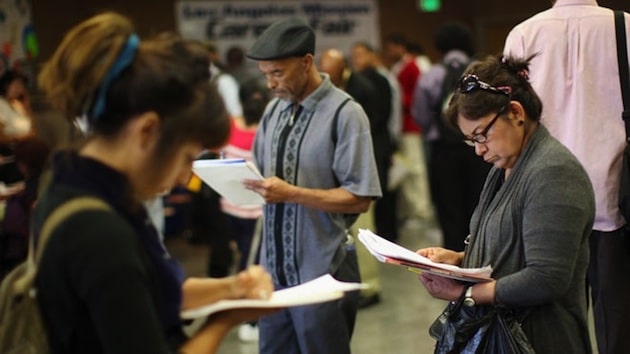

Americans seeking full- and part-time work fill out job applications at a workshop. (Photo: REUTERS)
The U.S. added 252,000 jobs in December and unemployment declined by 0.2 percentage point to 5.6, but participation ticked down to 62.7 percent. The employment-population ratio, a less-cited by equally important gauge, was a lagging 59.2 percent for the third consecutive month.
Still, monthly job gains are headed into their eleventh consecutive month above 200,000 jobs, though economists agree the economy must create an average of 250,000 monthly jobs to keep pace with population growth. When we include revisions for October and November, which increased total nonfarm payroll employment by 50,000, monthly job increases averaged 289,000 over the past 3 months. In 2014, job growth averaged 246,000 per month, juxtaposed to an insufficient 194,000 per month in 2013.
Economists had forecast 220,000 jobs created in December and that the unemployment rate would hold steady at 5.8 percent, which it would have if more people didn’t give up looking for work.
“Among people who were neither working nor looking for work in December, 2.3 million were classified as marginally attached to the labor force,” BLS Commissioner Erica L. Groshen said in a statement. This is little changed over the year.
“The number of discouraged workers, a subset of the marginally attached who believed that no jobs were available for them, was 740,000 in December,” she added.
The December job creation figures were widely expected to be strong given the additional seasonal hiring in retail to fill jobs needed during the holiday shopping season.
The Federal Reserve will certainly eye the latest labor market report when deciding the timing and trajectory of interest rate hikes, a move that would push both public and private borrowing costs higher and likely drag equities down.
When rates move higher, then it becomes more costly for consumers, government and businesses to borrow money. The higher costs for borrowing could cut back on consumer spending and business expansion, which could negatively impact labor markets. However, with the federal debt exceeding $18 trillion, the government now finds itself in a precarious situation.
Should the Fed raise interest rates to avoid adverse inflation pressure — in other words, do the right thing — or, continue to give the government a pass to spend?
The labor markets may appear to be stronger, as most focus on declines in the headline unemployment rate and superficial numbers over quality, the fact is that other labor market indicators suggest a slow recovery for most U.S. workers.
Average hourly wages, which have begun to receive more attention, have been stagnant for years, which has kept the Fed from meeting their inflation target rate of 2 percent.
During the past year, average hourly earnings have risen by an average of just 2.1 percent, well below the 3 percent – 3.5 percent rate the Fed targeted. The unemployment rate is likely to drop into the target range (5.2%-5.6%) in early 2015 (aided by declining participation), but the inflation target is not likely to be met. Inflation will not move until wages increase significantly, which frankly may not happen until late in 2015.





